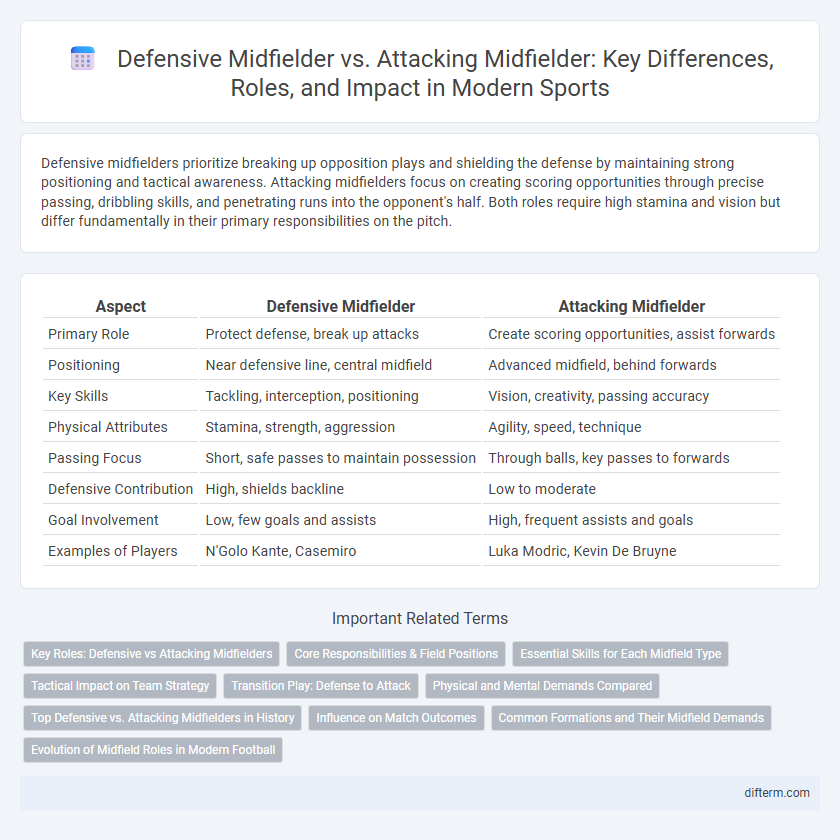Defensive midfielders prioritize breaking up opposition plays and shielding the defense by maintaining strong positioning and tactical awareness. Attacking midfielders focus on creating scoring opportunities through precise passing, dribbling skills, and penetrating runs into the opponent's half. Both roles require high stamina and vision but differ fundamentally in their primary responsibilities on the pitch.
Table of Comparison
| Aspect | Defensive Midfielder | Attacking Midfielder |
|---|---|---|
| Primary Role | Protect defense, break up attacks | Create scoring opportunities, assist forwards |
| Positioning | Near defensive line, central midfield | Advanced midfield, behind forwards |
| Key Skills | Tackling, interception, positioning | Vision, creativity, passing accuracy |
| Physical Attributes | Stamina, strength, aggression | Agility, speed, technique |
| Passing Focus | Short, safe passes to maintain possession | Through balls, key passes to forwards |
| Defensive Contribution | High, shields backline | Low to moderate |
| Goal Involvement | Low, few goals and assists | High, frequent assists and goals |
| Examples of Players | N'Golo Kante, Casemiro | Luka Modric, Kevin De Bruyne |
Key Roles: Defensive vs Attacking Midfielders
Defensive midfielders are primarily responsible for shielding the defense by breaking up opposition attacks, intercepting passes, and maintaining positional discipline to protect the backline. Attacking midfielders focus on creative playmaking, orchestrating offensive moves, providing key passes, and supporting forwards in scoring opportunities. The distinct roles emphasize defensive stability for defensive midfielders versus offensive creativity and goal involvement for attacking midfielders.
Core Responsibilities & Field Positions
Defensive midfielders primarily focus on protecting the backline by intercepting opposition passes, breaking up attacks, and maintaining positional discipline in the central defensive area. Attacking midfielders operate closer to the opposition's penalty box, orchestrating offensive plays, creating goal-scoring opportunities, and providing key passes or shots on target. Field positions for defensive midfielders typically center around the defensive third, while attacking midfielders occupy advanced central or wide areas to influence the final third.
Essential Skills for Each Midfield Type
Defensive midfielders require strong tackling, positional awareness, and intercepting abilities to shield the defense and break up opposition attacks. Attacking midfielders excel in vision, dribbling, and precise passing to create scoring opportunities and maintain offensive pressure. Mastery of ball control and spatial awareness is crucial for both roles to effectively manage the tempo and transition of play.
Tactical Impact on Team Strategy
Defensive midfielders anchor the team's structure by intercepting opposition attacks and distributing the ball to transition from defense to offense, enhancing overall team stability. Attacking midfielders drive offensive creativity, exploiting spaces between opposition lines to create goal-scoring opportunities through precise passes and strategic positioning. Their contrasting tactical roles balance defensive solidity with offensive potency, crucial for adapting team strategies to various in-game situations.
Transition Play: Defense to Attack
Defensive midfielders play a crucial role in transition play by quickly recovering possession and distributing accurate, short passes to initiate counterattacks, emphasizing stability and control. Attacking midfielders excel in transition by exploiting spaces and using creative vision to deliver incisive through balls or key passes that break defensive lines. Both roles demand sharp tactical awareness and rapid decision-making to turn defense into effective attacking opportunities.
Physical and Mental Demands Compared
Defensive midfielders require exceptional stamina, strength, and tactical awareness to intercept plays and shield the defense, demanding high physical endurance and mental focus to maintain positional discipline. Attacking midfielders rely more on agility, creativity, and quick decision-making to orchestrate offensive moves, which places intense cognitive pressure on spatial awareness and rapid problem-solving skills. Both roles demand distinct mental resilience and physical conditioning tailored to their specific in-game responsibilities, emphasizing the diverse athletic and psychological demands within the midfield.
Top Defensive vs. Attacking Midfielders in History
Top defensive midfielders like Claude Makelele and Sergio Busquets revolutionized the role with exceptional tactical awareness, positioning, and ball-winning skills, anchoring their teams' defense effectively. In contrast, attacking midfielders such as Zinedine Zidane and Andres Iniesta are celebrated for their creativity, vision, and playmaking abilities, orchestrating offensive moves and providing critical assists and goals. Historically, the distinction between these roles highlights varied skill sets, where defensive midfielders excel in disruption and coverage, while attacking midfielders drive forward momentum and scoring opportunities.
Influence on Match Outcomes
Defensive midfielders influence match outcomes by breaking up opposition plays, providing crucial interceptions, and maintaining team structure to prevent goals. Attacking midfielders drive offensive momentum through key passes, creating scoring opportunities, and contributing directly to goals with assists or finishes. Both roles are vital, but the balance between defensive stability and attacking creativity often determines a team's control and success in matches.
Common Formations and Their Midfield Demands
In common football formations like 4-3-3 and 4-2-3-1, the defensive midfielder often occupies a deeper central role, responsible for breaking up opposition attacks and providing defensive cover. The attacking midfielder typically plays higher up the pitch in formations such as 4-2-3-1 and 4-4-2 diamond, focusing on creating goal-scoring opportunities through key passes and dribbling in the final third. Midfield demands vary greatly as defensive midfielders prioritize tactical positioning and interception, while attacking midfielders emphasize creativity, vision, and quick decision-making.
Evolution of Midfield Roles in Modern Football
The evolution of midfield roles in modern football highlights a clear distinction between defensive and attacking midfielders, with defensive midfielders specializing in intercepting passes, breaking up opposition plays, and protecting the backline, while attacking midfielders focus on creativity, key passes, and goal-scoring opportunities. Tactical innovations and formations like the 4-2-3-1 have emphasized the importance of a deep-lying playmaker or a ball-winning midfielder positioned ahead of the defense, contrasting with the free-roaming, advanced playmaker responsible for linking midfield and attack. Modern football demands midfielders to adapt dynamically, with roles increasingly overlapping to maintain balance, facilitate transitions, and optimize team performance.
Defensive midfielder vs Attacking midfielder Infographic

 difterm.com
difterm.com